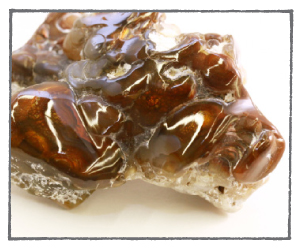AGATE

A MICROCRYSTALLINE QUARTZ, agate is a variety of chalcedony that’s often marked with banded patterns that are visible once the rock is cut. Some types, such as Moss agate and Sweetwater agate have organic-shaped markings as opposed to bands. The numerous varieties of agate are defined by their patterns and colors and are most often named for the location where they are mined. Some of the more common varieties include Mexican Lace agate (pictured following—with Fire agate above) and Brazilian agate.
Agate has been mined throughout the world. With its varying color and banding formations, it’s easy to understand why folklore about its properties varies widely. In most cultures, agate was used in ornamentation as both carved jewels and amulets of protection and it was once believed to grant the wearer the power of invisibility. The Romans believed it would aid in bringing in a good crop. In the Middle East, it was thought to keep one’s blood healthy. Shakespeare penned roles for agates in several of his works, and agate is listed in the King James version of the Bible in Exodus as one of the jewels placed upon Aaron’s Breastplate (see Zodiac and Birthstone Charts), each stone representing one of the original twelve tribes of Israel. Metaphysical practitioners believe agates to have great healing and balancing powers. Agates remain abundant to this day, and the finest examples are often used to create inexpensive jewelry or are cut to create bookends, plates, and carvings. Originally affiliated with the month of October, agate is the ayurvedic birthstone for May and is also associated with the birth sign Gemini.